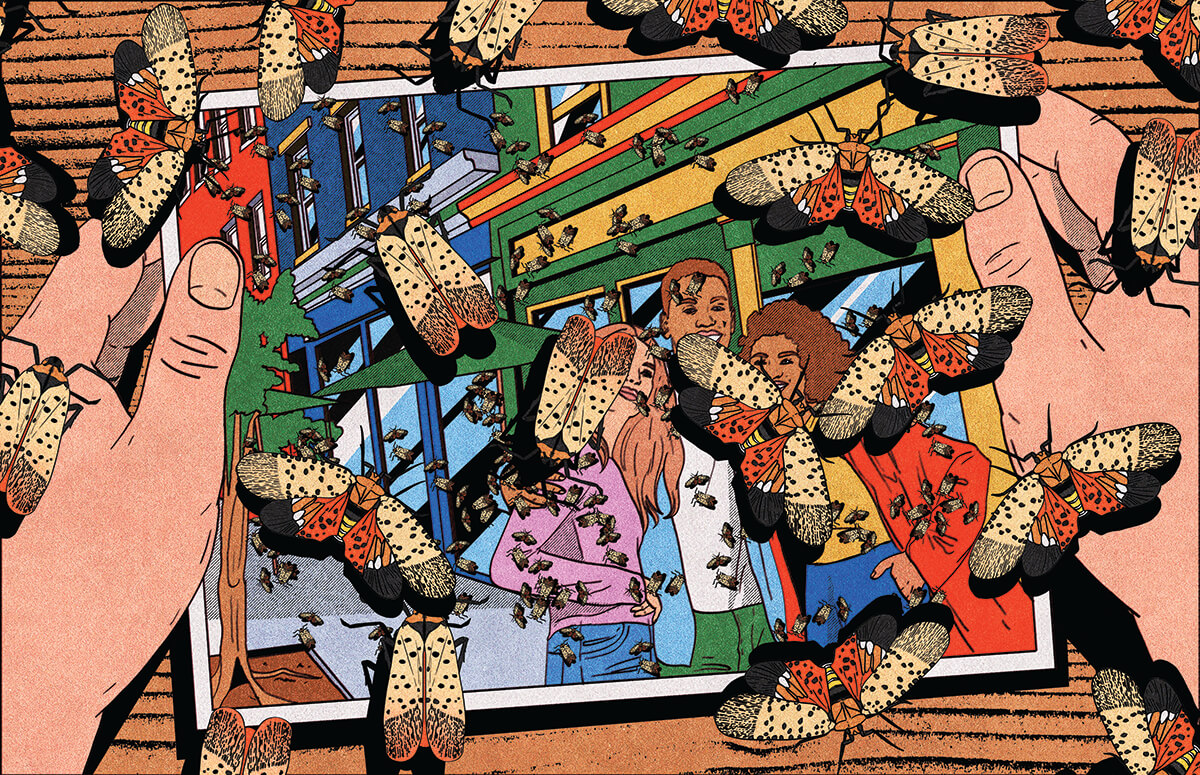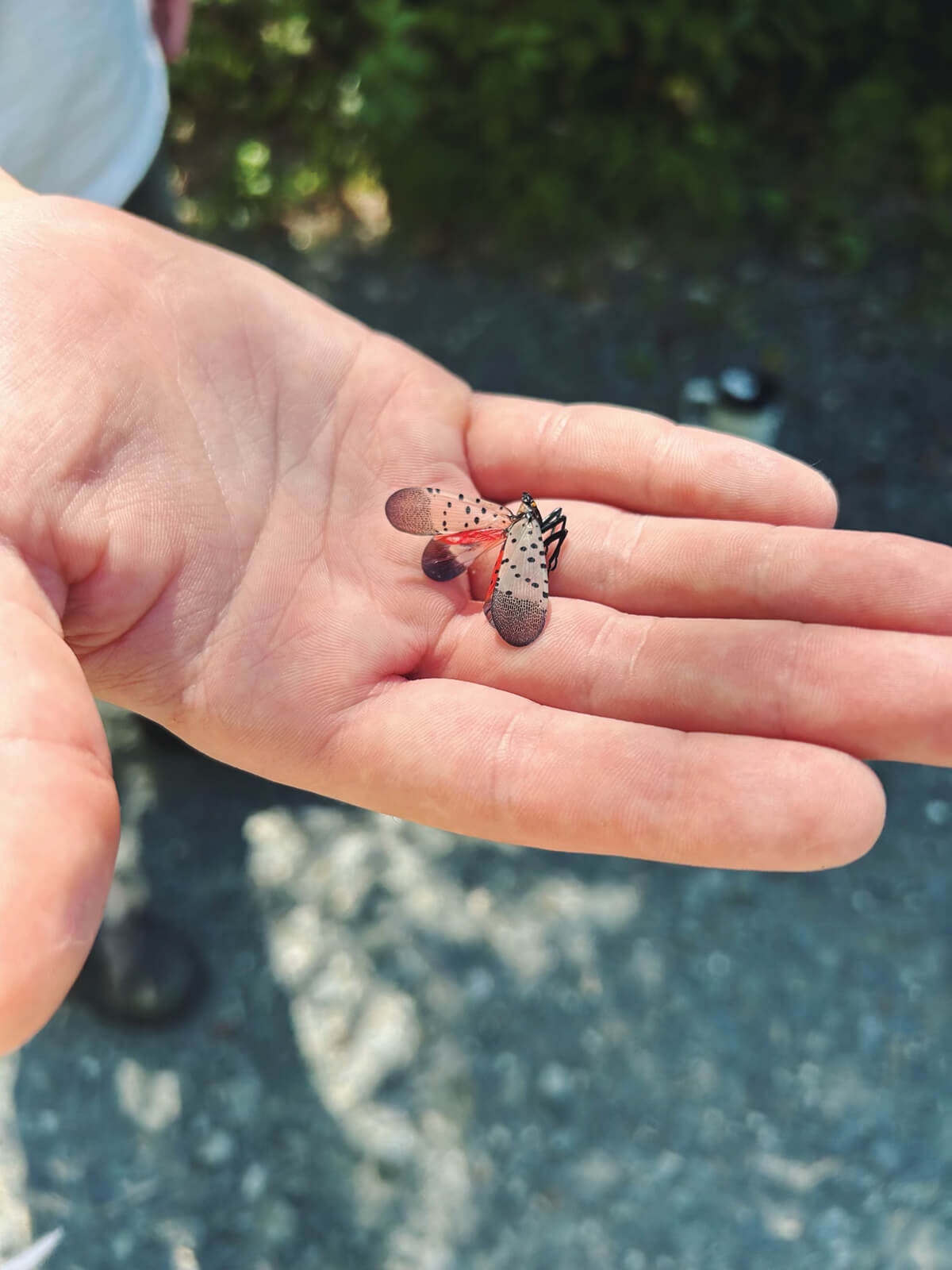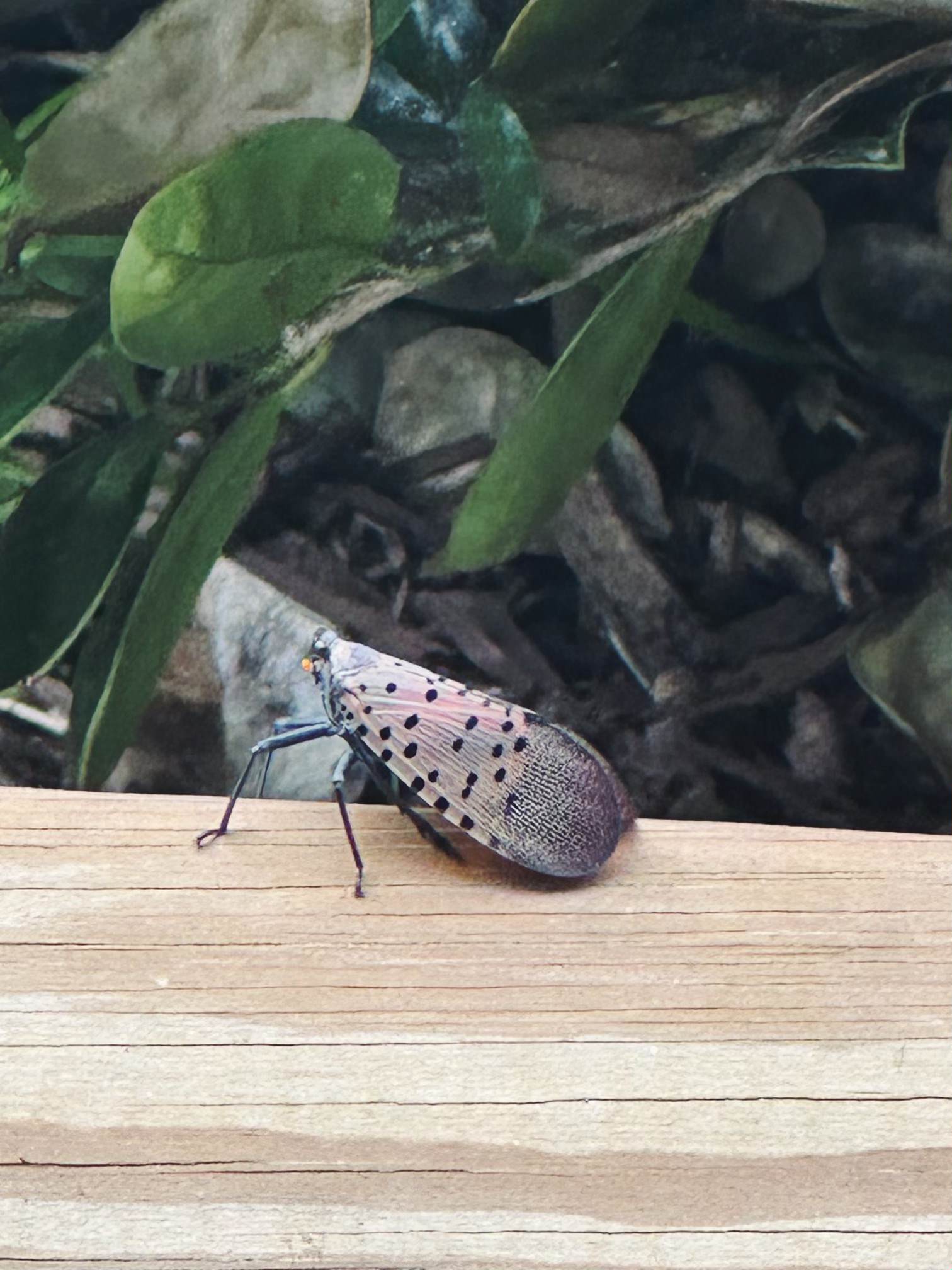Travel & Outdoors
For Better or Worse, the Spotted Lanternfly is Now Maryland’s Most Popular Bug
Move over cicadas—this highly invasive, non-native species is now spreading across the state.

Even from 10 feet away, I could tell that it was dead. Its left wing, speckled and translucent, bent unnaturally into the air. Its tiny legs, tucked lifelessly into its chest.
“Look what I found,” says Mike McCracken, field operations coordinator for the Maryland Department of Agriculture (MDA), walking across the small stone parking lot at the Severn Run Environmental Area in Millersville, his palm stretched wide to reveal the small insect.
“This is early in the year for an adult,” replies his colleague, Jessica Boyles, a raised brow lifting behind her cat’s-eye glasses. “Where did you see it? Did someone run over it? I wonder if we did that…”
She gestures toward two Chevy Silverados, each plastered with small white signs that identify their team—which today includes three assisting technicians, all in their 20s—as members of the state’s official Spotted Lanternfly Program.
And on this Friday morning in mid-July, they’re here in Anne Arundel County, about 10 miles down the road from the BWI Airport and Baltimore City line, for this very reason: to kill lycorma delicatula, or spotted lanternflies.

Formed in 2018, the small but growing staff of nine is tasked with documenting—and destroying—this highly invasive, non-native species that first showed up in Maryland that same year, near the Fair Hill Fairgrounds in Cecil County.
One lone specimen snuck over the Pennsylvania border, and they have since spread to 16 of the state’s 23 counties, only evading the farthest stretches of the panhandle, Eastern Shore, and Southern Maryland—for now.
“Is there any end in sight?” I ask Boyles, who oversees this crew.
“Extermination is not the goal at this point,” she says, matter-of-factly. “It is managing the populations. It is reducing the spread. It is making sure that they do not get any farther than they already are.”
Which is easier said than done, as evidenced by her team wandering around this shady oasis that’s just tucked off of the traffic on Veterans Highway.
Armed with vacuum backpacks, they amble between the trees, attempting to suck up juvenile lanternflies from the branches or tap them into plastic cups of high-proof alcohol—an intoxicating end.
At this stage in their life cycle, the tiny black-and-red bodies are difficult to spot. They have yet to grow their iconic wings, so they cling to the undersides of leaves, then scatter, disconcertingly quickly, as the nozzle moves in their direction.
Some get sucked into the cannister. Others inevitably escape.
After just a few minutes, it already seems as if they’re everywhere. But if one lands before you, the message from Boyles’ team is clear:
Squash it. Smash it.
“Squish it, then take a picture, then send it to us—even if it’s a dead body, I can tell,” she says, with uploads to the MDA’s online reporting system helping her track new infestations around the state. “When the adults fully emerge at the end of the month, we will get a flood of tips. Cecil and Harford have so many, they could fill my inbox. And Baltimore is popping off this year, too.”
It’s hard to believe, but not that long ago, most Americans had never heard of the now-prolific spotted lanternfly, which is quickly becoming the hottest bug in town. In the early 2000s, we were focused on the dwindling populations of the Monarch butterfly, or the emerging threat of the emerald ash borer, wreaking havoc on its namesake tree. Meanwhile, these pretty, polka-dotted planthoppers—more akin to katydids and cicadas than the winged butterflies or moths that they resemble—remained both out of sight, in their native Asia, and out of mind.
All that changed in 2012, when it is believed that a shipment of landscaping stone arrived in the United States from overseas with an unexpected stowaway: egg masses of the spotted lanternfly.
Within two years, the first infestation was identified in Berks County, Pennsylvania, and in swift succession, they scattered across the Commonwealth, often found in thickets of ailanthus altissima, or Tree of Heaven, an invasive, non-native plant, also from Asia, and the bug’s favorite food. And to make matters worse, it quickly became clear that they’re not picky eaters, snacking on everything from apple, cherry, and peach trees to sycamore, walnuts, and willows, raising alarm bells among the environmental community.
“Lanternflies eat everything in sight…the U.S. is looking delicious,” read a New York Times headline in 2018, when the insects were starting to sate themselves up and down the East Coast, now found as far north as Massachusetts, south as North Carolina, and west as Michigan.
In fact, their rise has been so fast and so furious, the spotted lanternfly catapulted itself into the cultural zeitgeist, from Halloween costumes to cameos on Saturday Night Live. (“They hatin’, I’m matin’!” hollered cast member Bowen Yang, his costume wings dangling like some dramatic high-fashion cape.)
“It’s weird!” exclaims Boyles, who follows Reddit threads for identifying mysterious insects, where one usual culprit is—you guessed it. “When I took this job, I thought I’d work on spotted lanternflies for a couple of years and then move on. But they have absolutely consumed everything.”
And no pun intended, as populations of spotted lanternflies are not only likely to keep growing in the 14 states already affected, but according to the U.S. Department of Agriculture—the sort of czar of invasive species, which funds the Maryland program—most of the 36 others are also at risk, with some experts expecting a West Coast invasion by 2027.
“IT’S BIG NEWS WHEN THE FIRST SHOWS UP…WE JUST SAID, OUR TIME HAS COME.”
That’s because:
“They’re hitchhikers,” says Paula Shrewsbury, entomology professor at the University of Maryland. “They don’t get on a plant and stay there their whole lives like some insects. They walk, they jump, they fly, and oftentimes, they land on or in vehicles, which allows them to be transported within and between states. So we can predict that they’re going to spread. Readily and rapidly.”
But Boyles is here to stop them, paying extra attention to locations near transportation hubs—highways, airports, rest stops, train stations—and recommending that motorists traveling to and from areas with known populations always check their cars before departure.
“They get into the cracks and crevices,” she says. “This time of year, I leave my windows rolled up and my truck bed closed. I have checked the outside and been driving down the road before I realize there’s one inside.”
Another reason why spotted lanternflies are so hard to control is their basic biology.
For starters, they’re small. In the spring, they emerge as tiny nymphs—first black in color with white dots, a mere eighth of an inch; then red with white dots and black stripes, double in size.
At this point, they resemble a small beetle or spider, and rather sprightly ones at that, using their mobility to also fend off potential predators, which are few and far between in the states.
“Quick, quick, quick,” says Boyles as she follows one up and around the branch of a Tree of Heaven before it leaps off into a tangle of greenbrier.
Management methods are a bit rudimentary, but scientists have few options beyond manual removal—aka squishing—or those cumbersome vacuums, or as a last but critical resort, given the numbers, chemical pesticides, which can harm beneficial native insects, too.
“We tell people to kill them,” says Boyles, “but they have to catch them first.”
At the height of summer, spotted lanternflies eventually do slow down, though, when they molt into oddly gorgeous adults and their gauzy gray-brown wings unfurl to reveal a freckle of black dots and splash of bright red coloring, like the dead one discovered in the parking lot this morning.
In this final stage, they grow upwards of an inch, then gather in large groups to suck the sap of trees together and ultimately find their mates. Throughout the fall, in areas where populations are plentiful, it is common to see hundreds of them, if not thousands, swarming a single trunk.
“How would you describe it?” I ask those who have seen this plague-like sight.
“That depends on how much you like insects,” says UMD’s Shrewsbury with a chuckle. “I think it can be disturbing for some people. I find it quite impressive.”
Luckily, initial concerns about the spotted lanternfly’s impact on local forests were overestimated. So far, they have not led to host tree mortality, particularly among mature hardwoods, unlike other intruders such as spongy moths, which have been particularly devastating to oaks. But last year, a study from Penn State University did find that swarms do indeed impair the growth of young silver and red maples, both native to Maryland.
And to make matters worse, after the insects finish their supper, they excrete a form of sticky sugar water known as honeydew, which can attract ants, wasps, and bees, as well as a black mold that can build up on the ground, trunks, and surrounding leaves, potentially blocking photosynthesis.
Boyles and others wonder what the long-term effects will be. “Would it make sense that years and years and years of stress could cause damage?” she poses, potentially making the infested trees more susceptible to disease, drought, or other pests. “Yeah, sure. Researchers are looking into it. It’s an important question.”
One thing we do know: Winemakers don’t get off so easily.
Turns out, the tender vines of both wild and cultivated grapes are especially tempting to the spotted lanternfly, forcing vineyards to prepare for the worst. And Harford County’s own Fiore Winery reportedly lost half of its harvest last year.
“It’s big news when the first shows up,” says Phin Deford, vice president at Boordy Vineyards in Baltimore County. “We saw one or two last summer, then in greater numbers by the fall. And we just said, our time has come.”
Deford notified the MDA, and last winter, Boyles made her first visit, in total removing some 21,000 egg masses.
These, too, are difficult to see, appearing like a slick of mud on myriad surfaces, from bicycles and barbecue grills to fence posts, barns, and buildings. Adult females lay at least two masses before the first frost, and each contains upward of 50 eggs. Quick math reveals: That’s a lot of spotted lanternflies, with millions likely now living throughout the state.
“We try to squish them if we can,” says Deford, whose crew monitors the fields daily. “I’m worried about the vines, of course, but also about the customers. We have a nice hillside with picnic tables where they like to enjoy their wine in the summertime. I can only imagine what that experience might be like if each tree has 10,000 bugs on it. And I’m not sure what we’re going to do about that, if and when the time comes.”

Before long, Baltimore City residents and businesses will likely be asking themselves similar questions.
The first spotted lanternfly landed on the edge of town in 2021, and now they’re making their rounds, from the Baltimore Museum of Art to the National Aquarium to Fort McHenry. Even the harbor is not off-limits, with some seen bobbing on the Chesapeake Bay.
“The population is significant, and it is rising,” says Megan Carr, forest ecologist with the Department of Recreation and Parks. “I’ve seen them in Druid Hill Park, Stony Run Park, and Herring Run Park. But they are scattered city-wide.”
It stands to reason that, soon enough, the season of spotted lanternflies could be just as ordinary as the annual emergence of other native insects, like fireflies in June—albeit not quite as lovely.
“I would say this is the less-fun version, it can be unsightly and cause a mess,” says Carr, recommending that residents clean the sheen of honeydew from high-use areas, like picnic tables, park benches, or patios. “My colleague calls them a neatnik’s nightmare. And that nuisance is really the main impact that we’re anticipating.”
To that end, her team has been focusing not on eradication but education. She emphasizes that the insects cause no harm to human beings. They don’t bite. They don’t sting. And so far, there is no evidence that they are poisonous to undiscerning pets.
“We’re trying to manage expectations and keep our residents informed,” says Carr, which includes teaching them how to identify spotted lanternflies—so they aren’t mistaken for native look-a-likes, like virgin tiger moths—as well as Tree of Heaven.
Walk into most woods in the city and you’ll find it: a slender trunk topped with a plume of long branches and blade-like leaves, almost as hard to eliminate as the bug it carries. Small seedlings can be removed with the entire root system, but simply cutting back larger saplings inspires the tree to send out aggressive new shoots, thus multiplying. Property owners should consult their local arborist.
But these trees are also how Boyles tracks down her archnemesis. Because otherwise, “It would take forever,” she says.
Five days a week, her team visits a variety of sites across the state—first applying their sunscreen, then checking the funnel-shaped traps that they attach to tree trunks (not the sticky ones, mind you, which can catch other wildlife, like birds, too), and averaging their kills for department records.
The entire top half of Maryland, minus Garrett County, is currently part of an official quarantine zone, requiring certain businesses, such as nurseries and landscapers, to obtain trainings, permits, and inspections in order to avoid transporting spotted lanternflies farther afield.
“Are you finding a lot?” Boyles asks field technician Erin Gehrdes.
“Not a lot a lot,” she replies.
“Some days, we’re looking and looking,” says McCracken, who shudders at the memory of swarms he encountered as a ranger at Susquehanna State Park. “Other days, the vacuum doesn’t turn off.”
And they couldn’t do it without the help of concerned citizens, with each uploaded photograph of a dead spotted lanternfly, be it through the MDA’s tip line or smartphone apps like iNaturalist, informing their efforts across this seven-million-acre state.
And perhaps that’s a silver lining: These insects—whether we like it or not—could inspire a generation to get reacquainted with the natural world, to become more aware of native species, to appreciate the interconnected roles that they play in their local ecosystems, and ultimately our lives.
“Invasives can sound alarming, but while they may not be from here, they are native to somewhere and they have real value there,” says Carr. “The problem is, when they are taken out of the context that they evolved in, it can throw things out of whack.”
Scientists are currently studying two native fungi that have been shown to naturally control spotted lanternflies in the wild. Meanwhile, the jury is still out over whether manual removal actually makes a noticeable dent. But the Maryland Spotted Lanternfly Program won’t be stopping anytime soon.
“It’s not their fault, they’re just trying to survive—same thing with stink bugs and Japanese beetles,” says Boyles, who hopes to get a tattoo of one someday. “Personally, I think they’re beautiful. And as an ecologist, I don’t like killing anything. But they don’t belong here. And they cannot stay.”
By 11 a.m., her crew has captured several dozen, their cannisters now slathered with a smattering of legs and some wings. They plod deeper into the forest, their socks pulled high to protect against another problematic insect—ticks—and as the temperature climbs into the upper 80s, they stop for water breaks and to shoot the breeze.
It’s an uphill battle, certainly, but no one seems discouraged. In fact, they each exude a lighthearted sense of duty. You might even call it pride.
“I’ll check my car on the way out,” I yell to Boyles, who disappears into the greenery.
“Yeah!” she shouts back. “Please do.”